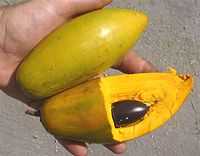Pouteria campechiana
| Canistel | |
|---|---|
 | |
| Scientific classification | |
| Kingdom: | Plantae |
| (unranked): | Angiosperms |
| (unranked): | Eudicots |
| (unranked): | Asterids |
| Order: | Ericales |
| Family: | Sapotaceae |
| Genus: | Pouteria |
| Species: | P. campechiana |
| Binomial name | |
| Pouteria campechiana Baehni | |
| Synonyms | |
|
Knuth | |

The canistel (Pouteria campechiana) is an evergreen tree native to southern Mexico and Central America.[1] It is cultivated in other countries, such as Brazil, Taiwan, and Vietnam for its fruit.
The canistel grows up to 10 meters (33 ft) high, and produces orange-yellow fruit, also called yellow sapote, up to 7 centimeters (2.8 in) long, which are edible raw. Canistel flesh is sweet, with a texture often compared to that of a cooked egg yolk, hence its colloquial name of "eggfruit." It is closely related to the Mamey sapote and abiu.
Fruit Description
The shape and size of the fruit is highly variable, depending on the cultivar. The better selections consistently produce large ovate fruit with glossy skin weighing upwards of 14 ounces. The flesh is somewhat pasty, although the best varieties have a creamy mousse-like texture. The flavor is rich and is reminiscent of an egg-custard.[2] The fruit may contain between one and six large brown seeds.
Uses
The canistel displays climacteric fruit ripening. A fully mature fruit shows an intense yellow skin colour. It will eventually soften and drop from the tree. Surprisingly, the fruit flesh remains untouched by insects or birds, perhaps because of astringent principles, that are much reduced in senescent fruits, but still perceptible to the human palate. Apparently mature fruits severed from the tree while still hard often fail to develop the desired climacteric changes in terms of reduced astringency and a texture reminiscent of egg yolk. This and the fact that climacteric fruits quickly start to decay at ambient temperatures may have contributed to the low economic importance of the canistel, a fruit species that many regard as delicious, and easy to process.
As the related lucuma the canistel can be eaten out of hand. The fruit flesh blended with milk or yogurt yields an attractive creamy shake or a more viscous, custard-like, mildly sweet and aromatic dessert.
Etymology
Its binomial name is derived from the Mexican town of Campeche, where it is native. It is sometimes (wrongly) referred to as Lucuma campechiana. In the Philippines it is called chesa. In Sri Lanka this fruit is known as Laulu, Lavulu or Lawalu.[3] In Thailand it is known by different traditional popular names such as Lamut Khamen (ละมุดเขมร="Khmer Sapodilla") or Tho Khamen (ท้อเขมร="Khmer Peach"), attributing a hypothetic Cambodian origin to this fruit (the name of the fruit is See Da, in Cambodia).[4] Currently those names are officially discouraged and the name Mon Khai (ม่อนไข่), Tiesa (ทิสซา), Khai meaning "egg", is favored.[5]
The plant's name in the Vietnamese language is cây trứng gà (“chicken egg” plant) because of the fruit's appearance. It also has the Vietnamese name lekima. This is very unusual because Vietnamese is a tonal, isolating language whose morphemes all consist of a single syllable. It appears that this name derives from the word lucuma.
References
- ↑ "Pouteria campechiana". Germplasm Resources Information Network. United States Department of Agriculture. Retrieved 2009-01-29.
- ↑ Boning, Charles (2006). Florida's Best Fruiting Plants: Native and Exotic Trees, Shrubs, and Vines. Sarasota, Florida: Pineapple Press, Inc. p. 53.
- ↑ D.K.N.G. Pushpakumara (2007). "Lavulu". Underutilized fruit trees in Sri Lanka. World Agroforestry Centre, South Asia Office, New Delhi, India.
- ↑ มีเมล็ดละมุดเขมรหรือเซียนท้อจำหน่าย
- ↑ 7 Health Benefits of Canistel
External links
| Wikimedia Commons has media related to Pouteria campechiana. |
- Julia F. Morton (1987). "Canistel". Fruits of Warm Climates. pp. 402–405. Retrieved 2010-09-24.